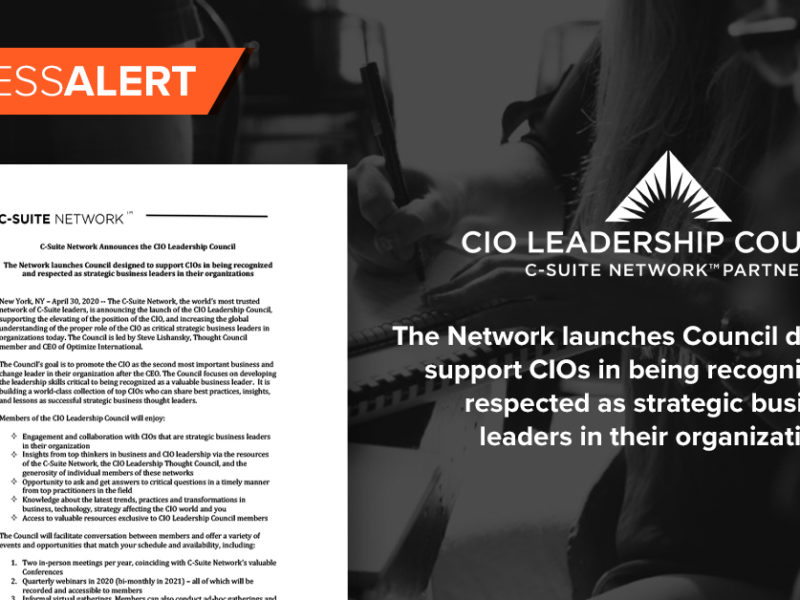
There May Be Dinosaurs Among Us: CIOs Face ‘A Darwinian Moment’
There May Be Dinosaurs Among Us: CIOs Face ‘A Darwinian Moment’ https://csuiteold.c-suitenetwork.com/wp-content/uploads/2015/03/6964359544_9f311d8517_z.jpg 640 425 C-Suite Network https://csuiteold.c-suitenetwork.com/wp-content/uploads/2015/03/6964359544_9f311d8517_z.jpgby Bob Dvorak

Two recent studies reveal a troubling rift between the CIO and other C-suite executives.
In this article, the first in a two-part series, we’ll explore some of the challenges facing CIOs today. Then, we’ll make some recommendations to CIOs to help them align and unify their organization’s IT strategy with their company’s business strategy.
CIOs may be facing an extinction-level event.
McKinsey & Co. reported last month that just over half of respondents in a recent survey of business executives, don’t see the CIO as a strategic business partner.
This is an incredibly troubling observation given the percentage of revenues companies spend today on IT – 5.1 percent on average (and growing), according to The Society for Information Management’s 2015 IT Trends Study (SIM), a leading professional association of IT leaders.
That means the largest companies in the world have IT budgets larger some large enterprises in their entirety. For example, if you apply the SIM formula to mega-retailer Wal-Mart – it likely spends more than $24 billion on IT alone – meaning Karenan Terrell, Wal-Mart’s executive vice president and CIO, runs an IT organization comparable to the size of well-known brands like Nike, Staples or Alcoa.
But it’s not just the giants spending huge dollars on IT. The average IT budget is just under $300 million, according to SIM survey participants, essentially making every business a digital business.
Further, SIM reports the amount of time the average CIO spent in 2014 with other C-suite executives increased sharply compared to 2013. In fact, now CIOs say they spend 241 percent more time with board directors and 29 percent more time with their CEO, compared to 2013, according to SIM.
With such massive amounts of spending at stake and more and more companies acknowledging their digital business transformation by way of increasing IT investments, and executive teams spending more time with the CIO – why is the rift between IT leadership and the rest of the C-suite so large?
According to McKinsey, it may be that the CIO has not aligned IT strategy with business strategy.
For example, reducing IT costs is one of the top three priorities for IT executives McKinsey surveyed. However it’s one of the bottom three priorities for business executives.
“We are in a time of profound change for business, technology, and IT leadership,” said Leon Kappelman, Ph.D., lead SIM researcher and professor of information systems at the University of North Texas. “The way companies are spending their IT dollars is changing; the way IT leadership is spending its time is changing; the entire focus of organizations – the way companies view the IT function and even IT leadership, itself, is changing.”
It’s not like CIOs don’t realize their role is changing. According to BT Global Services, a UK based communications and IT services provider, 85 percent of CIOs acknowledge their role is changing. And, as IBM’s Chief of Innovation Bernie Meyerson once said, “Those who stop innovating – disappear.”
It’s clear that CIOs are faced with “a Darwinian moment,” according to BT.
When CBS Interactive sought to fill its CTO/CIO position in 2011, it didn’t hire an IT leader from within or recruit a CIO from a competitor – it hired serial entrepreneur Peter Yared, (now Founder and CTO of application infrastructure company Saphos).
CBS Interactive took a chief executive from a technology company and made him its CIO rather than find someone who moved up the ranks with established IT leadership credentials.
According to McKinsey, 18 percent of executives believe a personnel change in the CIO/ top-IT executive’s offices is one of the most significant initiatives that could fix their organization’s IT shortcomings.
Jurassic World may not open until June, but there may be dinosaurs among us already. Even the strongest and most intelligent of the CIO breed may quickly become extinct if they don’t adapt to change.
 Bob Dvorak is Founder and President of KillerIT. He is responsible for KillerIT’s strategic direction and execution. Under his leadership, KillerIT continues to grow and succeed. During Bob’s 25 years at Forsythe, he has held a number of national management positions and earned numerous distinctions. Most recently, he was senior vice president, general manager, responsible for serving clients in the company’s Central Area. Prior, he was responsible for the establishment and development of the company’s Western Area, which experienced double-digit growth in product sales and professional consulting services under his leadership.
Bob Dvorak is Founder and President of KillerIT. He is responsible for KillerIT’s strategic direction and execution. Under his leadership, KillerIT continues to grow and succeed. During Bob’s 25 years at Forsythe, he has held a number of national management positions and earned numerous distinctions. Most recently, he was senior vice president, general manager, responsible for serving clients in the company’s Central Area. Prior, he was responsible for the establishment and development of the company’s Western Area, which experienced double-digit growth in product sales and professional consulting services under his leadership.




